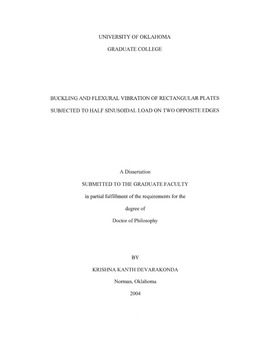| dc.contributor.advisor | Bert, Charles W., | en_US |
| dc.contributor.author | Devarakonda, Krishna Kanth. | en_US |
| dc.date.accessioned | 2013-08-16T12:19:18Z | |
| dc.date.available | 2013-08-16T12:19:18Z | |
| dc.date.issued | 2004 | en_US |
| dc.identifier.uri | https://hdl.handle.net/11244/689 | |
| dc.description.abstract | The problem of buckling of thin rectangular plates subjected to uniform and linearly varying in-plane load has been solved quite some time back beginning with the work of Bryan in 1890--91. Recently, Leissa and Kang obtained an exact solution in a series sense for the problem of buckling of rectangular plates subjected to linearly varying in-plane load. The case of buckling of rectangular plates subjected to nonlinearly varying in-plane load in the x direction received less attention, and the same problem was solved by van der Neut for the case of half-sinusoidal loading and by Benoy for the case of parabolic in-plane load. However, in their analyses, they considered an over-simplified in-plane solution by assuming the x-direction in-plane stress distribution to be the same at every plate section and the y-direction normal stress to be zero. | en_US |
| dc.description.abstract | The second part of the present work investigates the buckling loads of rectangular plates subjected to half-sinusoidal in-plane loads for various edge conditions involving simply supported and clamped edge conditions. Using the Galerkin method, buckling loads are estimated for various plate sizes, and the results are compared with finite element solutions. | en_US |
| dc.description.abstract | Based on the mechanics of the problem, one can expect that the x-direction in-plane stress distribution should exhibit the stress diffusion phenomenon as the plate aspect ratio is increased. The present work is threefold, wherein the first part deals with obtaining an in-plane elasticity solution for half sinusoidal edge loads on two opposite edges. Also present solution was compared with the in-plane solutions developed earlier in the literature as well as a numerical (finite element) solution. From the results thus obtained, it was concluded that the in-plane solutions were quite similar in terms of x-direction normal stresses. The y-direction normal stresses showed wide variations among the various methods and it was observed that some of the solutions produced some spurious stresses at the boundaries. | en_US |
| dc.description.abstract | In the third part, the natural frequencies and mode shapes of rectangular plates subjected to the above mentioned edge loads on two opposite edges are obtained. Using the in-plane elasticity solution developed in part one, flexural vibration analysis is carried out and the results are compared with those from finite element analysis. Extensive results of dimensionless frequencies are tabulated for reference. Further research is recommended. | en_US |
| dc.format.extent | xvi, 121 leaves : | en_US |
| dc.subject | Engineering, Mechanical. | en_US |
| dc.subject | Buckling (Mechanics) | en_US |
| dc.subject | Engineering, Aerospace. | en_US |
| dc.subject | Plates (Engineering) Fatigue. | en_US |
| dc.title | Buckling and flexural vibration of rectangular plates subjected to half sinusoidal load on two opposite edges. | en_US |
| dc.type | Thesis | en_US |
| dc.thesis.degree | Ph.D. | en_US |
| dc.thesis.degreeDiscipline | School of Aerospace and Mechanical Engineering | en_US |
| dc.note | Major Professor: Charles W. Bert. | en_US |
| dc.note | Source: Dissertation Abstracts International, Volume: 65-01, Section: B, page: 0404. | en_US |
| ou.identifier | (UMI)AAI3119184 | en_US |
| ou.group | College of Engineering::School of Aerospace and Mechanical Engineering | |
